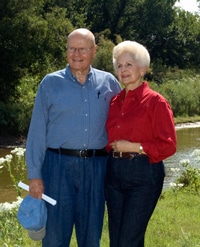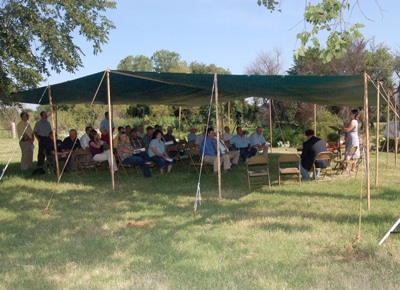Central North Canadian River Conservation District Hosts “Groundbreaking” Carbon Event

Approximately 40 people including news media gathered at a spot along the North Canadian River north of Geary on Aug. 28, 2008, to kick off a new program in Oklahoma. The Central North Canadian River Conservation District hosted the event on the land of Nadyne Burruss to mark the first land contracted in a Carbon Sequestration Pilot Program involving Western Farmers Electric Cooperative (WFEC), the Oklahoma Association of Conservation Districts (OACD) and the Oklahoma Conservation Commission (OCC).
With help from the local conservation district and a program from the Conservation Commission partially funded by the U.S. Environmental Protections Agency, Burruss will be able to fence off 80 acres of land bordering the river. Removing the land from cattle grazing will allow trees to grow that will result in increased soil carbon over the years (carbon sequestration). Burruss will be paid $3.50 per metric ton of carbon stored within the ecosystem.

In July the Oklahoma Conservation Commission initiated the Carbon Sequestration Certification Program. The program is designed to assist Oklahoma landowners and companies to take advantage of opportunities created by recently-established national and global carbon markets.
Carbon markets have been established as a way to reduce their greenhouse gas emissions. Many companies are already taking steps to reduce or offset their emissions, and they are paying to do so. Others are buying up offsets in hopes of using or selling them at a profit should the price of carbon rise higher. An emission offset occurs when greenhouse gases are removed from the atmosphere and stored in vegetation, soil, or underground. For example, trees take in CO2 during photosynthesis so a certain number of trees can offset a certain amount of CO2 by storing it in their trunks, roots, and soil. Grasslands and soils under no-till agriculture also store more carbon than degraded lands or soils under conventional tillage. Carbon can also be stored deep underground in geologic formations. The burgeoning demand for emission reductions and offsets is driving up the price of carbon, which peaked at $7 per metric ton in 2008, twice what it was last year.
The first program of its kind in the nation, OCC will certify and verify emission offsets in an effort to protect buyers and sellers. The agency does not buy or sell carbon offsets, but adds a layer of assurance that buyers are getting what they pay for and not causing harm to natural resources. OACD has created the Oklahoma Carbon Initiative (OCI) to serve as an “aggregator” of carbon offsets. That means the Oklahoma Carbon Initiative will contract with multiple land owners for the carbon offsets, bundle the offsets into quantities and sell them in either on- or off-market transactions. Western Farmers Electric Cooperative is sponsoring the pilot program by committing to purchase $100,000 of carbon offsets in the North Canadian River watershed over a three-year period. The project is part of a larger water quality improvement program, the North Canadian River 319 Project, for the North Canadian watershed from Canton Dam to Lake Overholser, involving portions of Dewey, Blaine and Canadian Counties. The 319 designation refers to section 319 of the federal Clean Water Act that authorizes cost share funds for projects to help improve nonpoint source water quality.

Dan Lowrance, OCC chairman, welcomed those in attendance to “…a historic occasion — the kickoff of a certifiable carbon credit program, the first of its kind in the nation.” Stacy Hansen, director of OCC’s new Carbon Program, and Sarah Love, OCI director, each explained their organizations’ role in the project. Gary Roulet, WFEC CEO, stated his company is committed to being a good steward of the environment and is eager to participate in carbon sequestration. Larry Watkins, general manager of the Oklahoma Association of Electric Cooperatives (OAEC) emphasized that “This is real environmentalism in a voluntary, cooperative program.” Shanon Phillips, OCC Water Quality assistant director, explained that in addition to carbon storage the benefits would extend to improving water quality of the North Canadian River. The protected and increased vegetation in the river side, or riparian, area would help water quality by filtering out sediment, pesticides, fertilizers and nutrients carried by rainwater runoff. In closing, Scotty Herriman, OACD�president, said that once again Oklahoma leads the nation in natural resource conservation. “This truly is a groundbreaking, milestone setting event as, once again, conservation districts lead the way in working with individuals and industry in protecting and improving out environment,” Herriman said.
